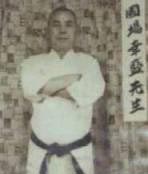 The founder of Seishin-Kai, Kokuba Kosei, the youngest son of a branch of the Okinawan Royal Family, the Sho Shi Family, was born in 1900, in the Kokuba Village or what is now Naha City, Okinawa. As a young boy he began training in the art of Karate with Master Motobu Choki, a student of Matsumura Sensei of Tomari. In 1924 he left his homeland of Okinawa for the larger islands of Japan. For several years he lived near Tokyo in the mountain village of Fuji-Yoshida-Shi, one of the small towns located at the foot of Japan’s awe inspiring Mount Fuji.
The founder of Seishin-Kai, Kokuba Kosei, the youngest son of a branch of the Okinawan Royal Family, the Sho Shi Family, was born in 1900, in the Kokuba Village or what is now Naha City, Okinawa. As a young boy he began training in the art of Karate with Master Motobu Choki, a student of Matsumura Sensei of Tomari. In 1924 he left his homeland of Okinawa for the larger islands of Japan. For several years he lived near Tokyo in the mountain village of Fuji-Yoshida-Shi, one of the small towns located at the foot of Japan’s awe inspiring Mount Fuji.
In 1944, Kokuba “Sensei” located in Osaka where he opened a business and also began formal teaching of the Okinawan Karate-Do of Master Motobu. On June 6th, 1943, Kokuba Sensei founded the Seishin-Kai Dojo. He took the name partly from the Kanji for the temple located at the end of the street where he lived, Shotennoji. The character Sho can be read as Sho or Sei and the meaning is “pure”. Kokuba “Sensei” believed that true Karate-Do come from the heart so he called his dojo – Seishin or “pure heart” dojo. During the difficult years of World War Il, many of the Okinawan Karate men left their homeland. Most of them came to Osaka and visited the home of their old friend, Kokuba Sensei. In return for room and board these men often taught at the Seishin-Kan dojo and gave private lessons to Kokuba Sensei’s young son, Kosho. The Seishin-Kan dojo became a famous meeting place for budo men in Osaka and the training was with the men who are the founders of Karate-Do as it is taught in the world today.
Kokuba Sensei continued to teach in the style of Motobu Sensei and when Master Motobu died in 1947, Kokuba Sensei became the second Soke or “Family Head” of the Ryu-Kyu Motobu-Ha Karate-Do. Born of the royal family and a samurai, Kokuba Sensei believed in the old traditions for samurai training. He trained his only son, Kosho, in the true samurai tradition. Kokuba Sensei continued to train and teach until he became ill in 1956. After his death in 1959, young Kosho became the third Soke of the Ryu-Kyu Motobu-Ha Karate-Do.
Seishin-Kai was founded in Japan in 1943 and its heritage is officially recorded in the Nippon Budokan Karate-Do directory. As a Karate-Do organization founded and headquartered in Japan, the Seishin-Kai is officially recognized by the Ministry of Education through the Zen Nippon Karate Do Renmei, also known as the Federation of All-Japan Karate-Do Organizations or FAJKO. This federation is also synonymous with the World Union of Karate Do Organizations or WUKO, now WKF (World Karate Federation). Thus, FAJKO/WUKO accredits Seishin Kai techniques, teaching methods, and certificates. Additionally, the older Nippon Karate-Do Rengo-Kai, a federation of some of the original Kai (clubs / associations), fully accredits Seishin-Kai.
Prior to 1958, Japan had no organization to regulate the growth and development of its many Karate systems. Several “Soke” and Masters of the more prominent systems saw the need for such a regulatory agency and they worked together to form an organization to serve this purpose. In 1958 the Nippon-Karate-Do Rengo-Kai was formed and Shogo Kuniba “Soke” was its first Office Manager. The President and financial backer was Sunji Sasagawa. The Rengo-Kai began as the only such regulatory agency in Japan and was comprised of organizations such as Seishin-Kai, Goju-Ryu, Shotokan, Shito-Ryu, Shorin-Ryu, Uechi-Ryu, Wado-Ryu, etc. Today, its composition remains basically the same. As Karate grew in Japan, a need arose to expand the regulatory commission and the Zen Nippon Karate-Do Renmei (Federation of All-Japan Karate-Do Organizations or FAJKO, now renamed Japan Karate Federation or JKF, was founded in 1968. The JKF includes the Rengo-Kai, the school and university Karate clubs, businessmen’s company clubs, all Japanese military clubs and Shito-Kai. Of the various organizations with the JKF, the Rengo-Kai remains the largest and Seishin-Kai is now one of the largest organizations within the Rengo-Kai. Therefore, Seishin-Kai is officially recognized by the Japanese Ministry of Education through the Zen Nippon Karate-Do Renmei (JKF). Seishin-Kai techniques, teaching methods, and certificates are thus officially accredited by both the Rengo-Kai and the JKF.
